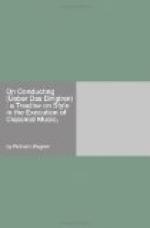Evidently the greater number, if not all modern Allegro movements, consist of a combination of two essentially different constituent parts: in contrast with the older naive unmixed Allegro, the construction is enriched by the combination of the pure Allegro with the thematic peculiarities of the vocal Adagio in all its gradations. The second theme of the overture to “Oberon,” which does not in the least partake of the character of the Allegro, very clearly shows this contrasted peculiarity. Technically, the composer has managed to merge the character of this theme into the general character of the piece. That is to say: on the surface, the theme reads smoothly, according to the scheme of an Allegro; but, as soon as the true character of the theme is brought out, it becomes apparent that A composer must think such A scheme capable of considerable modification if it is to Combine both principles. (Hauptcharactere.)
To continue the account of the performance of the Freyschutz overture at Vienna: after the extreme excitement of the tempo Allegro, I made use of the long drawn notes of the clarinet—the character of which is quite that of the Adagio—so as imperceptibly to ease the tempo in this place, where the figurated movement is dissolved into sustained or tremulous tone; so that, in spite of the connecting figure:
[music score example]
which renews the movement, and so beautifully leads to the cantilena in E flat, we had arrived at the very slight nuance of the main tempo, which has been kept up all along. I arranged with the excellent executants that they were to play this theme
[music score example]
legato, and with an equable piano, i.e., without the customary commonplace accentuation and not as follows:
[music score example]
The good result was at once apparent, so that for the gradual reanimation of the tempo with the pulsating
[music score example]
I had only to give the slightest indication of the pace to find the orchestra perfectly ready to attack the most energetic nuance of the main tempo together with the following fortissimo. It was not so easy on the return of the conflict of the two strongly contrasted motives, to bring them out clearly without disturbing the proper feeling for the predominant rate of speed. Here, when the despairing energy of the allegro is concentrated in successively shorter periods, and culminates in
[music score example]
the success of the ever-present modification of tempo was perhaps shown best of all.
After the splendidly sustained C major chords, and the significant long pauses, by which these chords are so well relieved, the musicians were greatly surprised when I asked them to play the second theme, which is now raised to a joyous chant, not as they had been accustomed, in the violently excited nuance of the first allegro theme, but in the milder modification of the main time.




